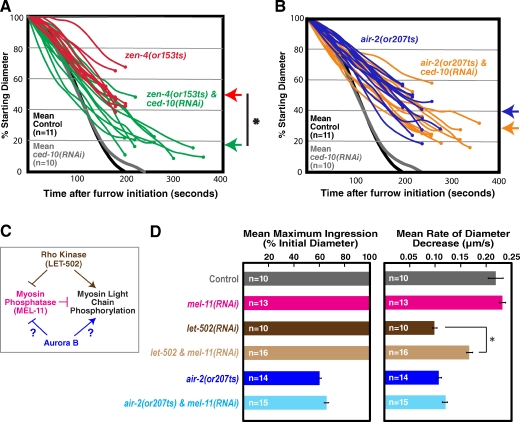Figure 4.
Depletion of RacCED-10 or the myosin phosphatase subunit MEL-11 does not alleviate the constriction defect resulting from inhibition of Aurora BAIR-2. (A and B) Traces of furrow diameter versus time for individual zen-4(or153ts) and zen-4(or153ts);ced-10(RNAi) embryos (A) or air-2(or207ts) and air-2(or207ts);ced-10(RNAi) embryos (B). Furrow diameters were measured in end-on projections of 11-plane z series collected every 20 s. Traces were smoothed by applying a three-point rolling mean. Circles mark the final diameter before regression. Arrows to the right of the graphs mark the mean maximum extent of ingression for each condition. For comparison, mean diameter is plotted versus time for control and ced-10(RNAi) embryos. The asterisk indicates that the mean extent of contractile ring constriction in zen-4(or153ts);ced-10(RNAi) embryos is significantly greater than that in zen-4(or153ts) embryos (two-tailed t test, P < 0.05). (C) A schematic illustrating the proposed role of Rho kinaseLET-502 in promoting myosin activation. Potential roles for Aurora BAIR-2 are indicated. (D) The mean maximum extent of ingression expressed as a percentage of initial diameter (left) and the mean rate of diameter decrease over the time interval 80–140 s after constriction onset (right) are shown for the indicated conditions. MEL-11 depletion alleviates the reduced constriction rate defect, resulting from inhibition of Rho kinase (LET-502) but not from inhibition of Aurora BAIR-2. Error bars are SEM. The asterisk indicates that constriction is significantly faster in let-502 & mel-11(RNAi) embryos than in let-502(RNAi) embryos (two-tailed t test, P < 0.05). All imaging was done using the postmeiotic upshift conditions outlined in Fig. 2 A.

